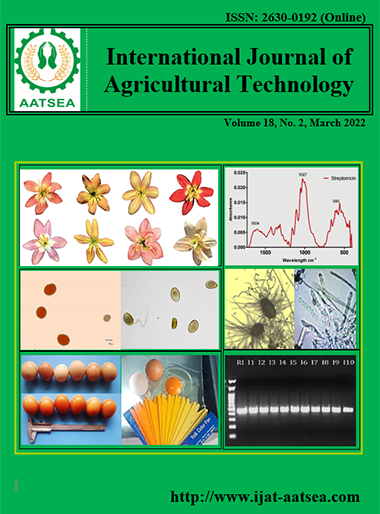Protein hydrolysates from agricultural wastes for plant bacterial disease control
Main Article Content
Abstract
Agricultural wastes, agro-industrial wastes and fishery wastes were collected and the protein hydrolysates were obtained with pepsin. Antibacterial activity of smaller than 3 kDa protein hydrolysates was determined against the plant pathogenic bacteria; Xanthomonas citri, Ralstonia solanacearum, Burkholderia cepacia and also against plant growth promoting rhizobacteria (PGPRs); Bacillus subtilis, Pseudomonas aeruginosa and P. fluorescens. Coconut residues (agro-industrial waste from coconut milk production), peanut seed coat (from peanut-based snack production) and rice straw (waste from rice farms) showed antimicrobial activity against X. citri, R. solanacearum and B. cepacia with higher than 74% inhibition. Coconut residue also increased growth of PGPRs, B. subtilis and P. fluorescens. Further protein hydrolysates from Nile tilapia (Oreochromis niloticus) and snake-head fish (Clarias batrachus) fin increased growth of all PGPRs.
Article Details

This work is licensed under a Creative Commons Attribution-NonCommercial-NoDerivatives 4.0 International License.
References
Bhattacharyya, P. N. and Jha, D. K. (2012). Plant growth-promoting rhizobacteria (PGPR): emergence in agriculture. World Journal of Microbiology and Biotechnology, 28:1327- 1350.
Champoiseau, P. G., Jones, J. B., Momol, T. M., Pingsheng, J., Allen, C., Norman, D. J., Caldwell, K. and Chu, W. (2010). Laboratory guide for identification of plant pathogenic bacteria, 3rd edn. APS Press, st. Paul, MN, pp.151-174.
Chaudhary, T. and Shukla, P. (2019). Bioinoculants for bioremediation applications and disease resistance: innovative perspectives. Indian Journal of Microbiology, 59:129-136.
Choi, J., Park, E., Lee, S. W., Hyun, J. W. and Baek, K. H. (2017). Selection of small synthetic antimicrobial peptides inhibiting Xanthomonas citri subsp. citri causing citrus canker. The Plant Pathology Journal, 33:87-94.
Daoubi, M., Hernandez-Galan, R., Benharref, A. and Collado, I. G. (2005). Screening study of lead compounds for natural product-based fungicides: antifungal activity and biotransformation of 6α, 7α-dihydroxy-β-himachalene by Botrytis cinerea. Journal of Agricultural and Food Chemistry, 53:6673-6677.
Ghorbanpour, M., Hatami, M., Kariman, K. and Abbaszadeh, D. P. (2016). Phytochemical variations and enhanced efciency of antioxidant and antimicrobial ingredients in Salvia ofcinalis as inoculated with diferent rhizobacteria. Chemistry and Biodiversity, 13:319-330.
Glick, B. R. (2012). Plant growth-promoting bacteria: mechanisms and applications. Scientifica (Cairo), 2012:963401.
Glick, B. R. (2014). Bacteria with ACC deaminase can promote plant growth and help to feed the world. Microbiological Research, 169:30-39.
Gray, E. J. and Smith, D. L. (2005). Intracellular and extracellular PGPR: commonalities and distinctions in the plant-bacterium signaling process. Soil Biology and Biochemistry, 37: 395-412.
Lee, T. H., Hall, K. N. and Aguilar, M. I. (2016). Antimicrobial peptide structure and mechanism of action: a focus on the role of membrane structure. Current Topics in Medicinal Chemistry, 16:25-39.
Lowry, O. H., Rosebrough, N. J., Farr. A. L. and Randall, R. J. (1951). Protein measurement with the Folin phenol reagent. The Journal of Biological Chemistry, 193:265-275.
Morais, T. P., Zaini, P. A., Chakraborty, S., Gouran, H., Carvalho, C. P., Almeida-Souza, H. O., Souza, J. B., Santos, P. S., Goulart, L. R., Luz, J. M. Q., Nascimento, R. and Dandekar, A. M. (2019). The plant-based chimeric antimicrobial protein SlP14a-PPC20 protects tomato against bacterial wilt disease caused by Ralstonia solanacearum. Plant Science, 280:197-205.
Oerke, E. C. (2006). Crop losses to pests. Journal of Agricultural Science, 144:31-43.
Park, I. Y., Cho, J. H., Kim, K. S., Kim, Y. B., Kim, M. S. and Kim, S. C. (2004). Helix stability confers salt resistance upon helical antimicrobial peptides. Journal of Biological Chemistry, 279:13896-13901.
Powers, J. P. S., Rosek, A. and Hancock, R. E. W. (2004). Structure activity relationship for the β-hairpin cationic antimicrobial peptide polyphemusin I. BBA: Journal of Proteins and Proteomics, 1698:239-250.
Shi, W., Li, C., Li, M., Zong, X., Han, D. and Chen, Y. (2016). Antimicrobial peptide melittin against Xanthomonas oryzae pv. oryzae, the bacterial leaf blight pathogen in rice. Applied Microbiology and Biotechnology, 100:5059-5067.
Sornwatana, T., Roytrakul, S., Wetprasit, N. and Ratanapo, S. (2013). Brucin, an antimicrobial peptide derived from fruit protein of Fructus Bruceae, Brucea javanica (L.) Letters in Applied Microbiology, 57:129-136.
Tantong, S., Pringsulaka, O., Weerawanich, K., Meeprasert, A, Rungrotmongkol, T., Sarnthima, R., Roytrakul, S. and Sirikantaramas, S. (2016). Two novel antimicrobial defensins from rice identified by gene coexpression network analysis. Peptides, 84:7-16.
Verma, R., Dutta, A., Choudhary, A. K. and Maurya, S. (2017). Effectiveness of combination of antibiotics on different isolates of ‘Ralstonia solanacearum’-A dreaded soil born phytopathogen and a causative agent of bacterial wilt. In: Mukhopadhyay K., Sachan A., Kumar M. (eds) Applications of Biotechnology for Sustainable Development. Springer, Singapore. pp.191-201.
Wang, Z. and Wang, G. (2004). ADP: the antimicrobial peptide database. Nucleic Acids Research, 32: D590-D592.
Zhang, L. J. and Gallo, R. L. (2016). Antimicrobial peptides. Current Biology, 26:R14-R19.
Zhao, X., Mei, W., Gong, M., Zuo, W., Bai, H. and Dai, H. (2011). Antibacterial activity of the flavonoids from Dalbergia odorifera on Ralstonia solanacearum. Molecules, 16:9775-9782.


